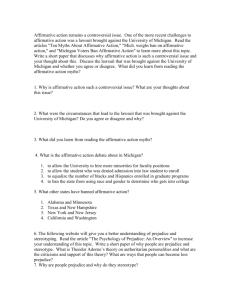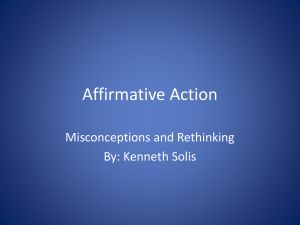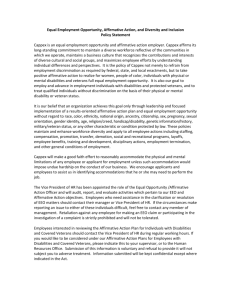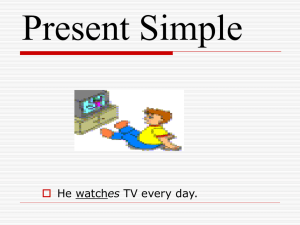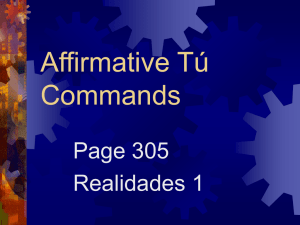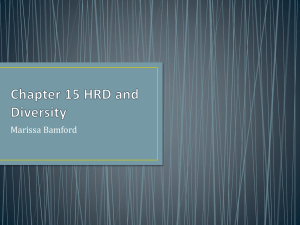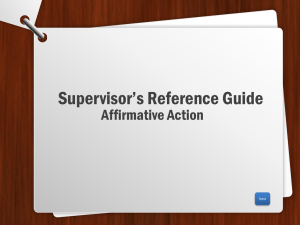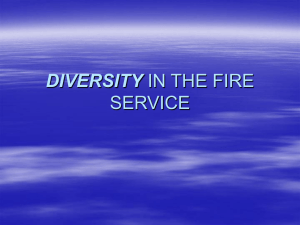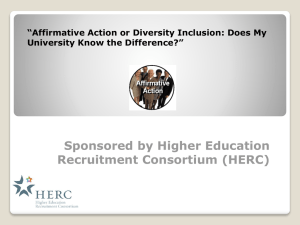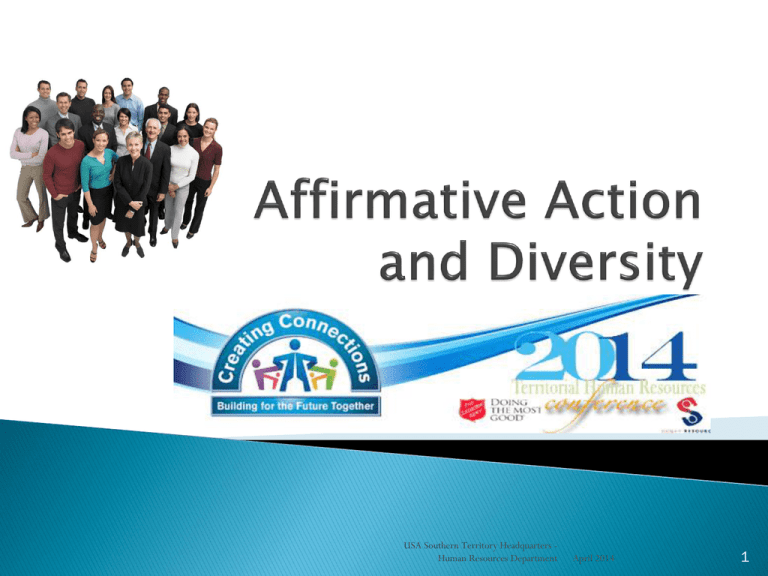
USA Southern Territory Headquarters Human Resources Department
April 2014
1
What is affirmative action?
What is diversity?
Distinguish between affirmative action and
diversity efforts
Offer practical suggestions to keep our
diversity efforts in alignment with our
affirmative action plans
USA Southern Territory Headquarters Human Resources Department
April 2014
2
The practice of improving the educational and
job opportunities of members of groups who
have not been treated fairly in the past due to
their race, color, national origin, religion, age,
sex, disability, veteran status, pregnancy, or
genetic information.
Affirmative action is supported by
nondiscrimination equal employment
opportunity (EEO) laws.
USA Southern Territory Headquarters Human Resources Department
April 2014
3
Requires government contractors and subcontractors to engage in self-analysis for the
purpose of discovering any barriers to equal
employment opportunities.
The Salvation Army Southern Territory now
has 25 affirmative action plans
The first plans were mandated in 2011 due to
our Federal Bureau of Prisons (BOP) contracts;
◦ Resulted in 14 plans
◦ Effective date April 1, 2012
USA Southern Territory Headquarters Human Resources Department
April 2014
4
2013 brought about discovery that our Veterans
Affairs (VA) federal contracts also included AA
requirements;
◦ Resulted in 11 additional plans
◦ Effective date April 1, 2014
NOTE: Currently, contracts for the U.S. Department
of Housing and Urban Development (HUD) and
Federal Emergency Management Agency (FEMA) are
under review and could trigger additional
affirmative action plans.
USA Southern Territory Headquarters Human Resources Department
April 2014
5
◦ Affirmative action prohibits discrimination but also
requires some positive steps to ensure EEO.
◦ Affirmative action must be practiced within the
limitations established by EEO laws.
◦ Affirmative action is what you do to make sure you
are not discriminating.
◦ The more you do to make sure you are not
discriminating, the less likely it is that you are
discriminating.
◦ When practiced appropriately. Affirmative action
can be a very effective risk management tool, and
serves as a stepping stone to diversity.
USA Southern Territory Headquarters Human Resources Department
April 2014
6
Diversity is
any collective
mixture
characterized
by similarities
and
differences.
7
Diversity affects everyone.
It is more than gender, age, racial
classification, ethnicity, physical ability and
sexual orientation.
8
Diversity determines how each individual
thinks, behaves, and believes. It is the lens
through which we see the
It encompasses all the influences that
shape the way we approach work and
daily living.
9
We have always thought of ourselves as the
world’s melting pot where everyone
embraced the same cultures and values.
10
Getting back to the melting pot means Valuing Diversity.
Valuing Diversity is a way of thinking that
allows individuals to both give and receive the
most in their relationships with co-workers and
customers.
11
Valuing Diversity is a process rather than a
program.
In order for an organization to Value
Diversity, the organization must be involved
in Diversity Management.
12
Managing Diversity means
managing the differences and
similarities that exist within our
workforce and within our
customer and client
populations.
13
Managing
Diversity
Affirmative Action
Understanding
Differences
14
How does Managing Diversity differ from
Understanding Differences?
The goals of Understanding Differences are:
◦ Creation of a diverse workforce
◦ Upward mobility for target groups
◦ Quality relationships at work
◦ Reduction of social conflict
The motivation stems from legal, moral, and
corporate social responsibility.
15
Limitations:
◦
◦
◦
◦
Emphasis on individual and interpersonal issues
Backlash
No change in systems or business culture
Requires continuous intense effort
16
How is Managing Diversity Different from
Affirmative Action?
Protects Everyone...
40+
17
In order to effectively Manage Diversity, the
organization must understand its
“BUSINESS CULTURE”
18
Requires Culture and Systemic Changes
Recruiting
Promotions
Sponsoring
Appraisals
Training & Development
Rewards
Mentoring
Career
Development
19
An organization’s vision or plan for diversity
and its’ management must extend well
beyond any legal requirements.
It must be driven by a business imperative to
provide an environment which releases the
productivity of each employee.
It is a business/viability issue to gain
competitive advantage in today’s markets.
20
21
“ A feeling, favorable or
unfavorable, toward a person or
thing, prior to contact, or not
based on actual experience.”
22
How do we acquire Prejudice?
Where do we acquire Prejudice?
When do we acquire Prejudice?
How can we overcome Prejudice?
23
“A standardized
mental picture
held in common
about members of
a group and
representing an
oversimplified
opinion, affective
attitude or
judgment”
24
There are positive and negative stereotypes
Stereotypes are a way of organizing
information and observations
Prejudice often causes people to create
stereotypes
Prejudice occurs when negative feelings
become attached to stereotypes
25
Application of limited experiences with one
member of a group to the ENTIRE group
Result from a need for coherence, simplicity,
and predictability in an increasingly complex
world
Used in our daily speech and jokes without
much contemplation
26
“The act, practice, or an instance of making
a difference in treatment or favor on a
basis other than individual merit.”
27
Most likely occurs when prejudice and
stereotypes affect decision making.
American companies and corporations spend
approximately $53 billion/year on resolving
alleged sexual or racial harassment and/or
discrimination complaints.
28
Illegal and prohibited by several laws
Bad for business
◦ Adversely impacts public image and relations
◦ Employee and customer relations
◦ Bottom-line of the organization
29
30

